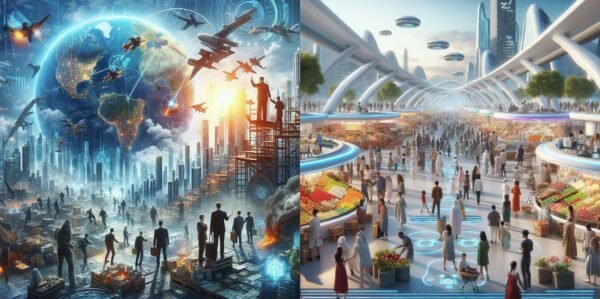2025 New Trade War Begins? The World is being divided into clans again

The global trade landscape is facing significant upheaval as 2025 unfolds, with the resurgence of trade tensions primarily driven by the anticipated policies of the newly re-elected U.S. President Donald Trump. This period is being characterized as “Trade War 2.0,” reflecting a potential escalation in tariffs and retaliatory measures, particularly between the United States and China.
Key Developments in Global Trade Policy
Resurgence of the U.S.-China Trade War: Analysts predict that the trade conflict that began in 2018 will intensify, with Trump’s administration expected to implement new tariffs on Chinese goods. This could lead to a broader economic fallout, dragging other nations into the fray and complicating international trade relationships.
Impact on China’s Economy: China’s growth is projected to be adversely affected by these renewed tensions, with forecasts suggesting a potential drop in GDP growth rates. The Chinese government is reportedly preparing for lower growth scenarios due to the expected tariffs, which could further exacerbate its economic challenges.
Global Economic Uncertainty: The anticipated trade war is contributing to a climate of uncertainty in global markets. Businesses are bracing for disruptions in supply chains as they prepare for potential tariffs that could affect various sectors. The overall economic growth forecast for 2025 remains cautious, hovering around 2.5% to 3% amid these geopolitical tensions.
Strategic Responses and Implications
Shift Towards Protectionism: The U.S. is expected to adopt a more protectionist stance, utilizing tariffs as tools for negotiating broader issues such as immigration and foreign policy. This approach could lead to retaliatory actions from affected countries, further straining international relations.
China’s Economic Strategy: In response to these pressures, China may need to pivot its economic strategy from an investment-led model to one focused on domestic demand. However, there are doubts about whether Chinese policymakers possess the necessary political will to implement such changes effectively.
Broader Global Impact: The ramifications of this trade war are likely to extend beyond just the U.S. and China, affecting countries that have previously managed to remain neutral. Nations will face difficult decisions regarding their trade policies as they navigate the complexities of aligning with either side in this escalating conflict.
As 2025 progresses, the world appears to be dividing into distinct economic “clans” based on alignment with major powers like the U.S. and China. The unfolding trade war not only threatens immediate economic stability but also poses long-term challenges to the established rules governing international commerce. Stakeholders across the globe must prepare for a potentially tumultuous period marked by heightened protectionism and shifting alliances in global trade dynamics.
A new phase of trade conflict has emerged as President Donald Trump has announced significant tariffs on imports from Canada, Mexico, and China. This escalation in trade tensions is characterized by a 25% tariff on the majority of goods from Canada and Mexico, alongside a 10% tariff on Chinese imports, set to take effect on February 4, 2025.
Key Details of the Tariffs
Tariff Rates:
Canada and Mexico: 25% on most imports.
China: 10% on various goods.
Justifications: Trump cited the need to combat illegal drug trafficking and immigration as primary reasons for these tariffs. He specifically referenced fentanyl, which has contributed to a significant number of overdose deaths in the U.S.
Economic Impact:
The tariffs are expected to increase prices for a wide range of consumer goods, including fruits, vegetables, electronics, and automotive components.
American businesses are preparing for the financial implications, with many reportedly stockpiling products before the tariffs take effect.
Potential Repercussions
Retaliation: Countries affected by these tariffs are anticipated to respond with their own levies on American exports, potentially leading to a broader trade war. Mexico has already indicated it might impose retaliatory tariffs on U.S. goods valued at approximately $360 billion.
Consumer Costs: Economists predict that these tariffs will lead to higher prices for consumers across various sectors, impacting everything from groceries to automotive purchases. The automotive industry is particularly vulnerable due to its integrated supply chains across North America.
Political Context: This move aligns with Trump’s long-standing campaign promises regarding trade policy and aims to bolster domestic manufacturing by making foreign goods more expensive. However, critics warn that such tariffs may ultimately harm American consumers and disrupt established supply chains.
As this situation develops, it remains crucial to monitor how both domestic and international markets respond to these new trade barriers and what further actions may be taken by the U.S. government in response to potential retaliatory measures from Canada, Mexico, and China.
The notion that the world is being divided into clans again reflects a growing trend towards identity politics and the re-emergence of tribal affiliations in various contexts. This phenomenon can be observed through several key developments:
1. Political and Social Movements
Identity Politics: There is a noticeable shift towards identity-based politics, where individuals align themselves with specific groups based on ethnicity, culture, or shared interests. This trend has been fueled by social media, which allows for the rapid mobilization of communities around common causes.
Indigenous Rights: Movements advocating for the rights of indigenous peoples are gaining momentum globally. Events like World Tribal Day highlight the need for recognition and protection of tribal rights, emphasizing their contributions to environmental conservation and cultural heritage.
2. Economic Disparities and Political Policies
Resource Allocation: Recent budget allocations in countries like India show a significant increase in funding aimed at improving the welfare of tribal communities, indicating a governmental recognition of their unique needs and contributions.
Policy Changes: However, proposals like Project 2025 in the U.S. threaten to roll back protections for marginalized communities, including indigenous populations, which could exacerbate divisions and inequalities.
3. Global Context
Geopolitical Tensions: The rise of nationalism and protectionist policies in various countries can be seen as a form of tribalism on a national scale, where countries prioritize their own interests over global cooperation.
There is a resurgence of tribal identities across various dimensions—political, cultural, and economic—this trend also poses challenges related to inequality and cultural preservation. The ongoing dialogue about indigenous rights and community welfare will be crucial in shaping how these divisions evolve in the future.
